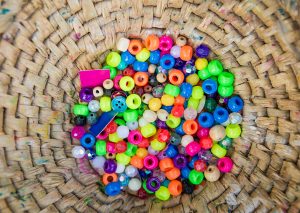Kids can use their imagination and try out new ideas through arts and craft activities.
You can encourage your child to get involved with craft activities by providing a space (throw down a drop sheet so mess can be easily cleaned up) and a few materials. Here are some suggestions for materials that kids love to get crafty with.
Arts and craft ideas
Painting
- Red, yellow and blue watercolour paint (or use food dye/powder paint in water).
- Red, yellow, blue, black and white acrylic/homemade paints.
- Painting tools: paint brushes (if possible with short, thick handles), sticks, cotton buds, string, spray bottles, rollers and sponges.
- Plastic containers or tubs (recycled food containers are ideal) and mixing palettes to hold paint and water.
Try making your own paint at home with the paint recipe further down this page.
Drawing
- Crayons: thick, wax crayons or oil-based pastels.
- A variety of drawing/writing pencils (for example, 2B, 2H, HB).
- Coloured pencils.
- Felt pens.
- Eraser and pencil sharpener.
3D art
- Playdough: bought or homemade.
- Clay or plasticine for creating sculptures and connecting materials like matchsticks and straws.
-
Collage materials and boxes.
Everyday materials
- Paper and card of different sizes and shapes (for example, white paper, recycled paper and cardboard, coloured paper, newspaper).
- Glue: glue stick/homemade glue and PVA glue recommended for collage and construction.
- Sticky and masking tape.
- Wool and string for threading and weaving.
- Magazines and catalogues.
- Recycled materials such as wood off-cuts, bark, leaves and fabric off-cuts.
- An apron or old t-shirt to protect clothing from paint and stains.
- Scissors.
- Pegs, washing line, drying rack, wire fence (for drying those amazing creations!).
Try making your own glue at home with the paste recipe further down this page.
Technology
- Computer and internet.
- Paint programs or photo software.
- Digital camera to create images, photograph artworks, and record learning.
Other arts materials
- Chalk/charcoal/pastels: for drawing.
- Aquarelle pencils: apply water to drawings (with a paint brush) to create a water colour effect.
- Building/construction materials (for example, wood off-cuts, hammer and nails, manipulative blocks/toys).
- Pipe cleaners: for painting with or creating sculptures/box construction.
- Coloured ice-block sticks/matchsticks, drinking straws: for collage/creating sculptures and designs.
Threading craft
Manipulating small objects helps to develop your child’s fine motor skills, visual tracking and hand-eye coordination skills.
Threading craft activities also help develop small muscle control, which is important for children as they are learning to write. As children become more capable in manipulating small objects, they also develop self-confidence and independence.
What you need:
- string, cord or wool (tied to a small object at the end)
- a bodkin or blunt needle
- a hole punch
- materials to be threaded (strips of paper, cut-up greeting cards, patty pans, straws, lace fabric, dry hollow pasta or beads).
Cut a piece of string, wool or cord long enough to make a necklace, tie a small object to one end as an anchor and a bodkin or blunt needle to the other.
Encourage your child to thread things onto the string. Discuss the size, colour and shape of the materials used and comment on the patterns or materials your child is trying out. To help them learn about patterns, demonstrate a pattern and ask your child to predict what would come next.
The finished threading can be made into a necklace or hung on a hook to be displayed.
Making paint
Paint can be used in most art experiments, from painting an image to decorating a creation. Finger painting also provides a sensory experience for children as they use the ‘feel’ of the paint to create layers and textures.
Soap flakes finger paint
What you need:
- 1-2 cups of warm water
- 1 cup soap flakes
- food colouring or powder paint*
*Powder paint is not suitable if your child may eat the dough.
What to do:
- Add water to soap flakes and beat until stiff.
- Colour with powder paint or food colouring.
Cornflour-based paint
What you need:
- 2 tablespoons cornflour
- ¼ -1/3 cup of cold water
- 2 cups boiling water
- food colouring or powder paint*
- disinfectant
*Powder paint is not suitable if your child may eat the dough.
What to do:
- Mix cornflour to a smooth paste with cold water.
- While stirring, gradually add boiling water until mixture thickens.
- Leave to cool (the mixture will thicken more as it cools, but should still pour easily).
- Add colouring and a few drops of disinfectant.
Mixture will keep in the refrigerator for about a week.
Making paste
Paste is a useful material that can be used in craft projects, such as cutting and pasting paper into a collage, or to make decorations. Try one of these recipes to create art materials at home.
Cornflour paste
What to do:
- Mix 2 tablespoons of cornflour with 1 cup of cold water.
- Stir over heat until mixture thickens.
- Store in refrigerator.
Flour paste
What to do:
- Mix ½ cup of flour with ¾ cup of cold water.
- Cook for several minutes over low heat, stirring constantly until the mixture thickens.
- Add a little disinfectant to keep the paste fresh.
- Store in refrigerator.
Other craft ideas
Visit the
ABC website for a collection of 'Make and Do' craft activities to try.